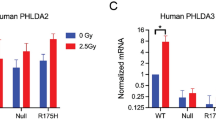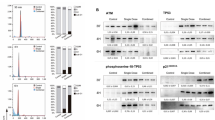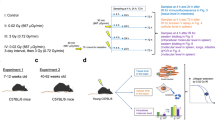Abstract
We have analysed the effects of p53 and of the apoptosis susceptibility gene Rapop1 (Radiation-induced apoptosis 1) located on chromosome 16 on glucocorticoid- and radiation-induced in vivo apoptosis of thymocytes. For those analyses, we used Rapop1 semicongenic mice heterozygous for the STS and BALB/cHeA alleles in the chromosomal segment containing Rapop1 in the BALB/cHeA background, mice bearing a p53 deficient allele in the BALB/cHeA background and the genetic crosses between these mice. The p53 wild type mice with a STS/A allele at the Rapop1 locus were less susceptible to both radiation- and glucocorticoid-induced apoptosis than those with homozygous BALB/cHeA alleles at this locus. Surprisingly, glucocorticoid-induced apoptosis was enhanced in the p53 hemizygous mice and considerably increased in the p53 nullizygous mice. In contrast, a sizable reduction of radiation-induced apoptosis was seen in the p53 hemizygous mice. The low susceptiblity to glucocortocoid-induced apoptosis linked to the STS allele of Rapop1 was less pronounced in the p53 hemizygous mice and a diminished effect of Rapop1 on radiation-induced apoptosis was seen in these mice. Although it remains to be established whether the genes modulating glucocortocoid-induced apoptosis are identical to p53 and Rapop1, our data suggest that p53 and Rapop1 may participate in glucocorticoid-induced apoptosis of thymocytes.
This is a preview of subscription content, access via your institution
Access options
Subscribe to this journal
Receive 50 print issues and online access
$259.00 per year
only $5.18 per issue
Buy this article
- Purchase on Springer Link
- Instant access to full article PDF
Prices may be subject to local taxes which are calculated during checkout

Similar content being viewed by others
References
Auphan N, DiDonato JA, Rosette C, Helmberg A and Karin M. . 1995 Science 270: 286–290.
Clarke AR, Purdie CA, Harrison DJ, Morris RG, Bird CC, Hooper ML and Wyllie AH. . 1993 Nature (London) 362: 849–852.
Demant P and Hart AAM. . 1986 Immunogenetics 24: 416–422.
Donehower LA, Harvey M, Slagle BL, McArthur MJ, Montgomery Jr CA, Butel JS and Bradley A. . 1992 Nature (London) 356: 215–221.
Gavrieli Y, Sherman Y and Ben-Sasson SA. . 1992 J. Cell. Biol. 119: 493–501.
Goodrow TL, Storer RD, Leander KR, Prahalada SR, van Zwieten MJ and Bradley MO. . 1992 Mol. Carcinog. 5: 9–15.
Guidos CJ, Williams CJ, Grandal I, Knowles G, Huang MTF and Danska JS. . 1996 Genes. Dev. 10: 2038–2054.
Iwata M, Hanaoka S and Sato K. . 1991 Eur. J. Immunol. 21: 643–648.
Kerppola TK, Luk D and Curran T. . 1993 Mol. Cell. Biol. 13: 3782–3791.
Ko LJ and Prives C. . 1996 Genes Dev. 10: 1054–1072.
Levin AJ. . 1997 Cell 88: 323–331.
Lowe SW, Schmitt EM, Smith SW, Osborne BA and Jacks T. . 1993 Nature (London) 362: 847–849.
Marchetti P, Casted M, Susin SA, Zamzami N, Hirsch T, Macho A, Haeffner A, Hirsch F, Geuskens M and Kroemer G. . 1996 J. Exp. Med. 184: 1155–1160.
Mori N, Okumoto M, Morimoto J, Imai S, Matsuyama T, Takamori Y and Yagasaki O. . 1992 Int. J. Radiat. Biol. 62: 53–159.
Mori N, Okumoto M, van der Valk MA, Imai S, Haga S, Esaki K, Hart AM and Demant P. . 1995a Genomics 25: 609–614.
Mori N, Okumoto M, Hart AAM and Demant P. . 1995b Genomics 30: 553–557.
Scheinman RI, Cogswell PC, Lofquist AK and Baldwin Jr AS. . 1995 Science 270: 283–286.
Shimizu S, Eguchi Y, Kamiike W, Waguri S, Uchiyama Y, Matsuda H and Tsujimoto Y. . 1996 Oncogene 13: 21–29.
Stassen AP, Groot PC, Eppig JT and Demant P. . 1996 Mamm. Genome 7: 55–58.
Vacchio MS and Ashwell JD. . 1997 J. Exp. Med. 185: 2033–2038.
van Wezel T, Stassen AP, Moen CJ, Hart AA, van der Valk MA and Demant P. . 1966 Nature Genet. 14: 468–470.
Weil MM, Xia X, Lin Y, Stephens LC and Amos CI. . 1997 Genomics 45: 626–628.
Wyllie AH. . 1980 Nature (London) 284: 555–556.
Yu C, Yap N, Chen D and Cheng S. . 1997 Cancer Lett. 116: 191–196.
Acknowledgements
We thank Drs LA Donehower and A Bradley for their kind gift of p53 deficient mice. We also thank Drs J Allen, GG Gomez and AAM Hart of The Netherlands Cancer Institute for their helpful discussion during preparation of this paper. This publication is partly supported by a research subsidy from the Showa Shell Sekiyu Environmental Research Foundation to Dr N Mori, by a grant from the Japan Atomic Energy Research Institute, by the contract of the Nuclear Safety Research Association to Dr M Okumoto, and by a grant from the Dutch Cancer Foundation to Dr P Demant.
Author information
Authors and Affiliations
Rights and permissions
About this article
Cite this article
Mori, N., Yamate, J., Stassen, A. et al. Modulations of glucocorticoid-induced apoptosis linked to the p53 deletion and to the apoptosis susceptibility gene Rapop1 (Radiation-induced apoptosis 1). Oncogene 18, 4282–4285 (1999). https://doi.org/10.1038/sj.onc.1202719
Received:
Revised:
Accepted:
Published:
Issue Date:
DOI: https://doi.org/10.1038/sj.onc.1202719



